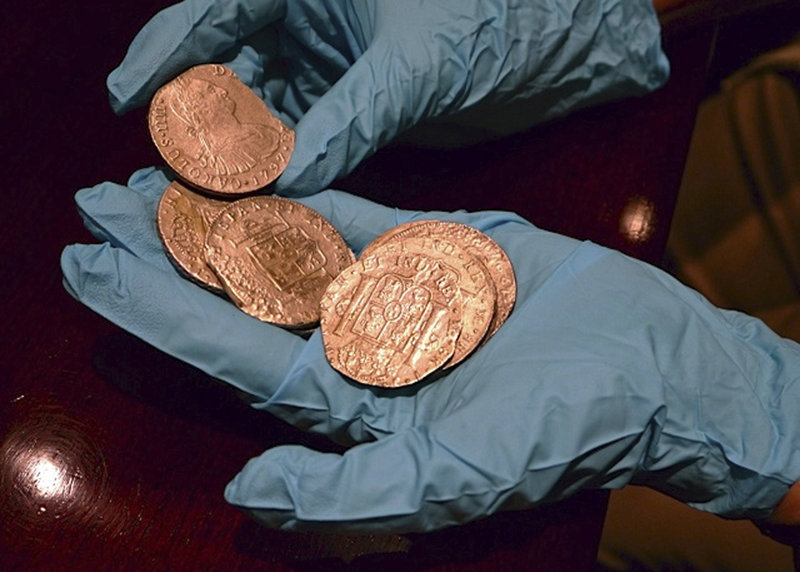TAMPA, Fla. – A 17-ton haul of silver coins, lost for two centuries in the wreck of a sunken Spanish galleon, began its journey back to its home country on Friday after the deep-sea explorers who lifted it to the surface lost their claim to ownership.
Two massive cargo planes – Spanish military C-130s – took off just after noon from a Florida Air Force base with 594,000 silver coins and other artifacts aboard. They were packed into the same white plastic buckets in which they were brought to the U.S. by Tampa, Fla.-based Odyssey Marine Exploration in May 2007.
“These are emotional and moving moments for me and all my colleagues behind me,” Spain’s ambassador to the United States, Jorge Dezcallar de Mazar, said Friday. He stood on the windy tarmac at MacDill Air Force base behind the hulking gray planes, flanked by an entourage of more than two dozen Spanish officials and others.
“History will make us who we are, and today we are witnessing a journey that started 200 years ago,” he said. “This is not money. This is historical heritage.”
The C-130s lifted off into a clear sky minutes apart from a MacDill runway as a bank of news cameras and a group of reporters observed from the tarmac. Inside, the buckets of coins were secured to pallets with plastic wrap and strapped into the rear cargo holds. Before their departure, the planes were guarded by armed American service members.
Odyssey made an international splash when it discovered the wreck, believed to be the Nuestra Senora de las Mercedes, off Portugal’s Atlantic coast near the Straits of Gibraltar. At the time, the coins were estimated to be worth as much as $500 million to collectors.
The Mercedes was believed to have had 200 people aboard when it was sunk.
Spain went ahead with transporting the treasure despite a last-ditch, longshot claim to the treasure by Peru.
On Thursday, the Peruvian government made an emergency appeal to the U.S. Supreme Court seeking to block transfer of the treasure to give that nation more time to make arguments in federal court about its claim to being the rightful owner. But that appeal was denied Friday by Justice Clarence Thomas.
Peru had argued the gold and silver was mined, refined and minted in that country, which at the time was part of the Spanish empire.
Odyssey – which uses a remote-controlled submersible to explore the depths and bring the tiniest of items to the surface – had previously argued that as the finder it was entitled to all or most of the treasure. The Spanish government filed a claim in U.S. District Court soon after the coins were flown back to Tampa, contending that it never relinquished ownership of the ship or its contents. A federal district court first ruled in 2009 that the U.S. courts didn’t have jurisdiction, and ordered the treasure returned.
Odyssey had argued that the wreck was never positively identified as the Mercedes. And if it was that vessel, the company contended, then the ship was on a commercial trade trip – not a sovereign mission – at the time it sank, meaning Spain would have no firm claim to the cargo. International treaties generally hold that warships sunk in battle are protected from treasure seekers.
Odyssey lost every round in federal courts trying to hold on to the treasure, as the Spanish government painted them as modern-day pirates plundering the nation’s cultural heritage. Odyssey has said in earnings statements that it has spent $2.6 million salvaging, transporting, storing and conserving the treasure. But it is not expected to receive any compensation from the Spanish government for recovering it because the European nation has maintained that the company should not have tried to do so in the first place.
Copy the Story Link
Send questions/comments to the editors.



Success. Please wait for the page to reload. If the page does not reload within 5 seconds, please refresh the page.
Enter your email and password to access comments.
Hi, to comment on stories you must . This profile is in addition to your subscription and website login.
Already have a commenting profile? .
Invalid username/password.
Please check your email to confirm and complete your registration.
Only subscribers are eligible to post comments. Please subscribe or login first for digital access. Here’s why.
Use the form below to reset your password. When you've submitted your account email, we will send an email with a reset code.